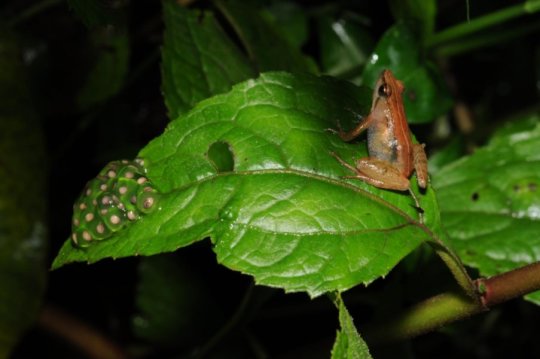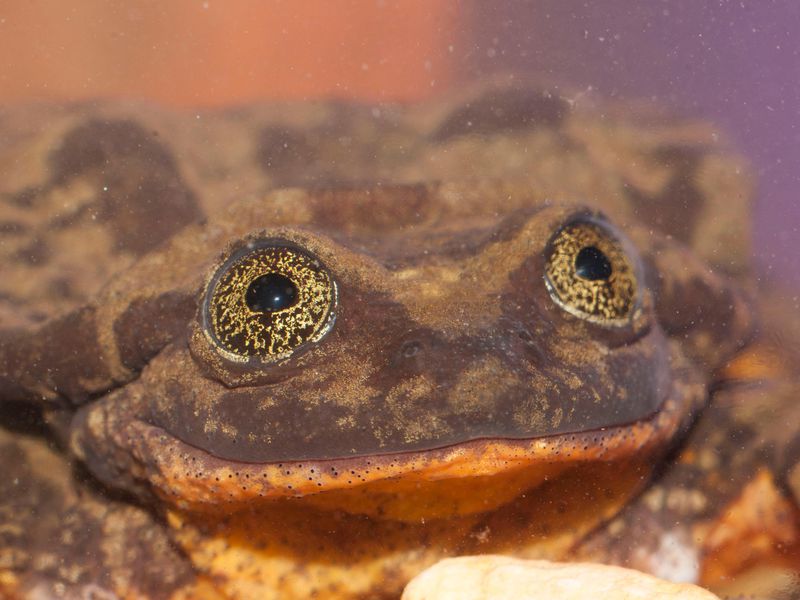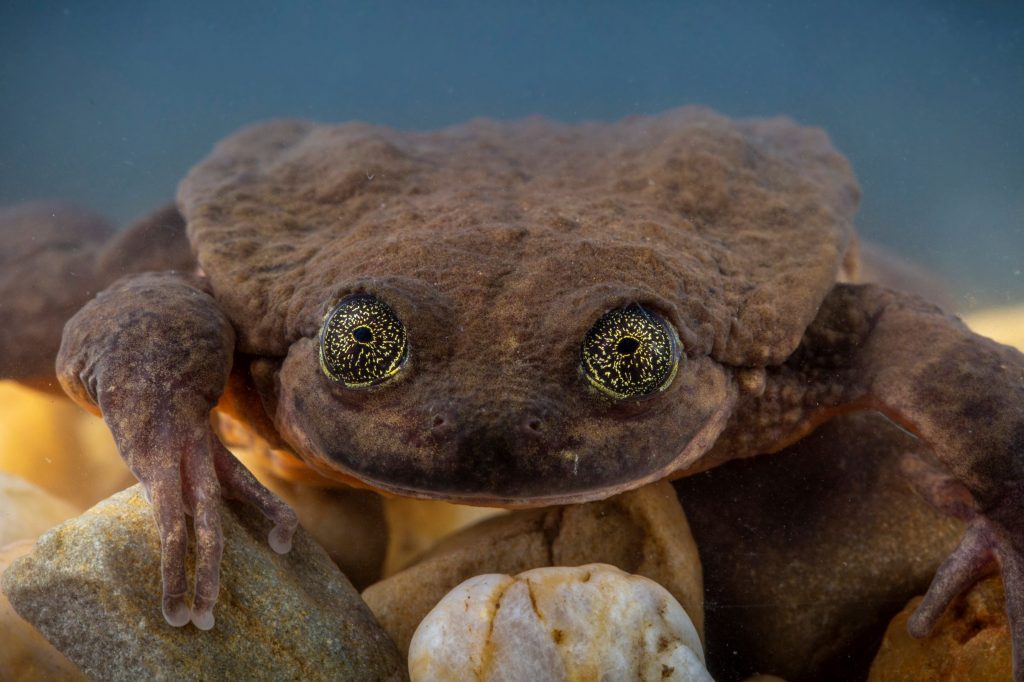It seems to be to my week for being a day late. Here’s my Valentine Day (February 14, 2019) celebration posting. I’ve got two frog stories, news of a dating app for animals, and a bonus (not a frog story) at the end.
Ethiopia
For the last few years I’ve been getting stories about new frog species in Central and South America. This one marks a change of geography. From a February 12, 2019 news item on ScienceDaily,
A new species of puddle frog (order: Anura, family: Phynobatrachidae, genus: Phrynobatrachus), has just been discovered at the unexplored and isolated Bibita Mountain in southwestern Ethiopia. The research team named the new species Phrynobatrachus bibita sp. nov., or Bibita Mountain dwarf puddle frog, inspired by its home.

Here’s more from a February 13, 2019 New York University Abu Dhabi press release (also on EurekAlert), which originated the news item (Note: I have reformatted parts of the following press release),
In summer 2018, NYU Abu Dhabi Postdoctoral Associates Sandra Goutte and Jacobo Reyes-Velasco explored an isolated mountain in southwestern Ethiopia where some of the last primary forest of the country remains. Bibita Mountain was under the radars of the team for several years due to its isolation and because no other zoologist had ever explored it before
“Untouched, isolated, and unexplored”
“It had all the elements to spike our interest,” says Dr. Reyes-Velasco, who initiated the exploration of the mountain. “We tried to reach Bibita in a previous expedition in 2016 without success. Last summer, we used a different route that brought us to higher elevation,” he added.
Their paper, published in ZooKeys journal, reports that the new, tiny frog, 17 mm for males and 20 mm for females, is unique among Ethiopian puddle frogs. Among other morphological features, a slender body with long legs, elongated fingers and toes, and a golden coloration, set this frog apart from its closest relatives. “When we looked at the frogs, it was obvious that we had found a new species, they look so different from any Ethiopian species we had ever seen before!” explains Dr. Goutte.
Back in NYU Abu Dhabi, the research team sequenced tissue samples from the new species and discovered that Phrynobatrachus bibita sp. nov. is genetically different from any frog species in the region.
“The discovery of such a genetically distinct species in only a couple of days in this mountain is the perfect demonstration of how important it is to assess the biodiversity of this type of places. The Bibita Mountain probably has many more unknown species that await our discovery; it is essential for biologists to discover them in order to protect them and their habitat properly,” explains NYU Abu Dhabi Program Head of Biology and the paper’s lead researcher Stéphane Boissinot, who has been working on Ethiopian frogs since 2010.
About NYU Abu Dhabi
NYU Abu Dhabi is the first comprehensive liberal arts and science campus in the Middle East to be operated abroad by a major American research university. NYU Abu Dhabi has integrated a highly-selective liberal arts, engineering and science curriculum with a world center for advanced research and scholarship enabling its students to succeed in an increasingly interdependent world and advance cooperation and progress on humanity’s shared challenges. NYU Abu Dhabi’s high-achieving students have come from 120 nations and speak over 120 languages. Together, NYU’s campuses in New York, Abu Dhabi, and Shanghai form the backbone of a unique global university, giving faculty and students opportunities to experience varied learning environments and immersion in other cultures at one or more of the numerous study-abroad sites NYU maintains on six continents.
These are very small frogs with males growing to about 17mm, or 0.6 inches and females growing up to 20mm, or 0.8 inches.
Here’s a link to and a citation for the paper,
A new species of puddle frog from an unexplored mountain in southwestern Ethiopia (Anura, Phrynobatrachidae, Phrynobatrachus) by Sandra Goutte, Jacobo Reyes-Velasco, Stephane Boissinot. ZooKeys, 2019; 824: 53-70 DOI: 10.3897/zookeys.824.31570 (12 Feb 2019)
This paper appears to be open access.
Bolivia
First, here’s some background information. I wrote about Romeo, the Sehuencas water frog last year in my July 26,2018 posting: ‘Emergency!!! Lonely heart looking for love: Female. Stocky build. Height of 2 – 3 inches,’

“(Matias Careaga) [downloaded from https://www.smithsonianmag.com/smart-news/scientists-made-matchcom-profile-bolivias-loneliest-frog-180968140/]That is a very soulful look. How could any female Sehuencas water frog resist it? Sadly, that’s the problem. They havn’t found any female Sehuencas water frogs yet.
It’s not for want of trying. Back in February 2018 worldwide interest was raised when scientists as the Cochabamba Natural History Museum (Bolivia) started a campaign to find a mate and raise funds for a search. …”
Happily, I stumbled on this January 17, 2019 New York Times article by JoAnna Klein for the latest about Romeo,
Romeo was made for love, as all animals are. But for years he couldn’t find it. It’s not like there was anything wrong with Romeo. Sure he’s shy, eats worms, lacks eyelashes and is 10 years old, at least. But he’s aged well, and he’s kind of a special guy.
Romeo is a Sehuencas water frog, once thought to be the last one on the planet. He lives alone in a tank at the Museo de Historia Natural Alcide d’Orbigny in Bolivia.
A deadly fungal disease threatens his species and other frogs in the cloud forest where he was found a decade ago. When researchers brought him to the museum’s conservation breeding center, they expected to find another frog he could mate with and save the species from extinction. But they searched stream after stream, and nothing.
…
He needed a match before he croaked, so last year conservation groups partnered to create a Match.com profile for him. People related to Romeo’s romantic struggles, and on Valentine’s Day last year, the company and his fans raised $25,000 to send an expedition team out to the cloud forest to find his Juliet.…
And for all the lonely lovers searching for that special someone, Teresa Camacho Badani, a herpetologist at the museum who found Juliet [emphasis mine], has another message: “Never give up searching for that happy ending.”
Here is Juliet,

If you don’t have much time, Klein’s article goes on to offer an engaging look at the successful expedition’s trip. For anyone who might like to keep digging, I have more. First, a video,
Global Wildlife Conservation has a January 15, 2019 posting (where I found the video) by Lindsay Renick Mayer which offers more detail via a Q&A (questions and answers) interview with Teresa Camacho Badani, the herpetologist who found Juliet. Here’s an excerpt to whet your appetite,
Q. What was the habitat like where you found the frogs?
A. It is a well-preserved cloud forest where the climate is rainy, foggy and humid because of the streams, which are less than a meter in width with currents that form waterfalls, and ponds that are not very deep. Other biologists had looked here for the frog, even last year, with no success. We selected this spot after months of doing an analysis of historic records of where the species had originally been found—most of which have since been destroyed. Field evidence suggests that the frog is very, very rare and there are likely few left in the wild. And because it was clear that the threats to the frogs were so close in proximity—the streams around us were empty—we decided to rescue all five of these individuals for the conservation breeding program.…
Q. What happens to these five frogs next?
A. Right now they’re in quarantine at the K’ayara Center at the museum, where they are starting to acclimate to their new home. We’ll make sure they have the same quality of water and temperature as in the field. After they are used to their new habitat and they’re eating well, we will give them a preventive treatment for the deadly infectious disease, chytridiomycosis. We do not want Romeo to get sick on his first date! [emphasis mine] When the treatment is finished, we can finally give Romeo what we hope is a romantic encounter with his Juliet.…
The Global Wildlife Conservation’s January 15, 2019 press release offers still more information,
…
“It is an incredible feeling to know that thanks to everyone who believes in true love and donated for Valentine’s Day last year [2018], we have already found a mate for Romeo and can establish a conservation breeding program with more than a single pair,” said Teresa Camacho Badani, the museum’s chief of herpetology and the expedition leader. “Now the real work begins—we know how to successfully care for this species in captivity, but now we will learn about its reproduction, while also getting back into the field to better understand if any more frogs may be left and if so, how many, where they are, and more about the threats they face. With this knowledge we can develop strategies to mitigate the threats to the species’ habitat, while working on a long-term plan to return Romeo’s future babies to their wild home, preventing the extinction of the Sehuencas water frog.”
These are the first Sehuencas water frogs that biologists have seen in the wild in a decade, though over the years (including in 2018) scientists had searched this area for the species with no success. This team, which had done careful analysis ahead of time to determine the best places to look for the frogs, still didn’t encounter the Sehuencas water frog until after failing for a few long days to find any frogs of any species in what seemed like perfect amphibian habitat—a well-protected stream in the Bolivian wilderness. …
…
The scientists are hoping for more money (from Global Wildlife Conservation’s January 15, 2019 press release),
Romeo became an international celebrity on Valentine’s Day in 2018 with a dating profile on Match, the world’s largest dating company. Now he is a powerful flagship for conservation in Bolivia. These expeditions were made possible by the individuals in more than 32 countries who made donations last year that were matched by Match for a total of $25,000.
“Our entire Match community rallied behind Romeo and his search for love last year,” said Hesam Hosseini, CEO of Match. “We’re thrilled with this outcome for Romeo and his species. He now joins the list of millions of ‘members’ who have found meaningful relationships on Match.”Romeo’s followers can continue to cheer on him and his species by making a donation to support these conservation efforts. They can also stay up to date on these expeditions and other news about the most eligible bachelor through GWC’s blog, mailing list and social media platforms (Facebook, Twitter and Instagram) and the Alcide d’Orbigny Natural History Museum’s Facebook page. Romeo has also now taken to Twitter to share his thoughts on dating, love and romance.
Animal dating apps
Do check out Romeo’s Twitter feed. You may find something appealing such as this link to a February 14, 2019 news item on the News for Kids blog which discusses dating apps for animals. Romeo’s story is recounted and then there’s this about an app for farm animals,
…
In the United Kingdom a company called Hectare has come up with “Tudder” – an unusual way for farm animals to find partners.
Tudder is a “dating” app which allows farmers to easily find mates for their cows and bulls. Farmers can post pictures of their animals to the app, and swipe through pictures and descriptions to see other animals in need of a mate.
…
Tudder may sound a bit silly, but farmers say it saves them time and money because they don’t have to travel with their animals to find them a mate.
Funny thing is, I was wondering about Romeo just the other day and so, thanks is owed to the Beakerhead Twitter feed where I stumbled across the Romeo update. Thank you
Bonus
I have two furry bonuses. First, the cats,
The excerpt is from the CBC (Canadian Broadcasting Corporation’s February 15, 2019 article by Devon Murphy about ‘Catwalk: Tales From The Cat Show Circuit’, a CBC documentary as is this excerpt,
Her hair is perfect, freshly washed, blow-dried, and combed, and her eyes are shining. She’s ready to compete and is calm as the judge approaches. Then, he takes a feather and twitches it in front of her face, and she turns on her back, furry stomach exposed, and bats at it with her immaculate paws.
…
Now for the pièce de résistance. Thank you to LaineyGossip (fifth paragraph) for this moment of “pure joy”,
That dog knows she’s a champion, whether or not she’s the fastest on the course. On February 10, 2019, she was a furry streak of lightning … in the 8″ division of the Westminster Dog Show’s Masters Agility Championship competition. Belated Happy Valentine’s Day.